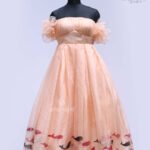March 5, 2024
Embroidery Clothing in Indian Fashion
Embroidery Clothing in Indian Fashion
Embroidery has been a cornerstone of Indian fashion for centuries, adding a touch of elegance and sophistication to both traditional and contemporary attire. The intricate designs and vibrant colors of Indian embroidery reflect the rich cultural heritage and artistic prowess of the country. Let’s explore some of the most popular embroidery styles in Indian fashion and their significance.
"The relationship between an Indian woman and saree is that of a snake. It’s a relationship of misunderstanding. It’s easy to wear saree."
-Sabyasachi Mukherjee
Chikankari: The Elegance of Lucknow
Chikankari, believed to have been introduced by Noor Jahan, the wife of Mughal Emperor Jahangir, is a delicate and artful embroidery style originating from Lucknow, Uttar Pradesh. Traditionally done with white thread on white fabric, Chikankari has evolved to include a variety of colors and fabrics such as muslin, silk, chiffon, and cotton. The motifs, often inspired by nature, are meticulously hand-stitched, making each piece a unique work of art.
Zari and Zardosi: The Royal Embellishments
Zari and Zardosi embroidery, introduced by the Mughals in the 16th century, are synonymous with opulence. Zari involves weaving metallic threads into fabrics, while Zardosi takes it a step further by incorporating gold and silver threads, often embellished with precious stones and pearls. This form of embroidery is commonly seen on bridal wear, making it a symbol of luxury and grandeur.
Phulkari: The Floral Splendor of Punjab
Phulkari, meaning “flower work,” is a traditional embroidery style from Punjab. Characterized by its vibrant colors and floral patterns, Phulkari is typically done on coarse cotton fabric using silk threads. The embroidery is dense and covers the entire fabric, creating a rich tapestry of colors and designs. Phulkari is often used in shawls, dupattas, and bridal trousseaus, symbolizing joy and prosperity.
- Chikankari
- Zari/Zardosi
- Aari
- Banjara
- Phulkari
- Zardosi

Kantha: The Storytelling Stitches of Bengal
Kantha embroidery from Bengal is known for its simplicity and storytelling. Originally a way to reuse old sarees and dhotis, Kantha involves running stitches to create intricate patterns depicting scenes from daily life, nature, and folklore. This embroidery style is now popular in quilts, sarees, and home décor items, cherished for its rustic charm and cultural narratives.
Mirror Work: The Reflective Beauty of Gujarat and Rajasthan
Mirror work, or Shisha embroidery, is a striking feature of traditional attire from Gujarat and Rajasthan. Small mirrors are sewn onto the fabric using a variety of stitches, creating a dazzling effect. This embroidery is often seen on lehengas, cholis, and home décor items, adding a touch of sparkle and festivity.
Aari: The Hooked Needle Art
Aari embroidery, practiced in regions like Rajasthan, Lucknow, and Kashmir, involves a hooked needle to create chain stitch loops. This technique allows for intricate designs and is often embellished with beads and sequins. Aari work is known for its fine detailing and is commonly used in bridal wear and festive garments.
Banjara: The Nomadic Craft
Banjara embroidery, created by the nomadic Banjara tribes, is characterized by its vibrant colors, mirror work, and intricate patterns. This embroidery style is often seen on bags, skirts, and blouses, reflecting the rich cultural heritage of the Banjara community.
Embroidery in Indian fashion is not just a decorative art but a reflection of the country’s diverse cultural heritage. Each embroidery style tells a story of its origin, technique, and significance, making Indian fashion rich and vibrant. Whether it’s the elegance of Chikankari, the opulence of Zardosi, or the rustic charm of Banjara, embroidery continues to play a vital role in Indian fashion, bridging the gap between tradition and modernity.
Comments ( 1 )
Comments are closed.














Volutpat ac tincidunt vitae semper quis. Quam adipiscing vitae proin sagittis nisl. Senectus et netus et malesuada. Dignissim sodales ut eu sem integer vitae justo. Placerat duis ultricies lacus sed turpis tincidunt id. Aliquet nec ullamcorper sit amet risus. Orci porta non pulvinar neque laoreet suspendisse interdum.